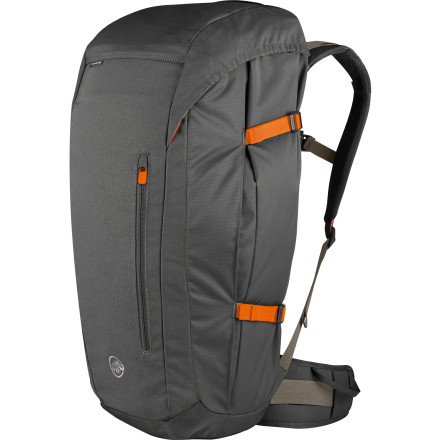Mammut Neon Pro Pack Review
 More than half of my climbing days are spent at a roadside crag called Rifle Mountain Park. Other days, I’m dropping into the Black Canyon or hiking into Rocky Mountain National Park for multi-pitch routes. The Mammut Neon Pro has been great for everything that I’ve put it through so far. Its vent V-frame suspension, light weight (2 pounds, 3 ounces), and economical design provide an efficient way to schlep 40 liters worth of metal, nylon, food, water, helmet, camera and rain gear around the mountains. (Or, if I’m sport climbing, substitute “helmet” and “camera” with duct tape, rubber kneepads and three pairs of shoes.)
More than half of my climbing days are spent at a roadside crag called Rifle Mountain Park. Other days, I’m dropping into the Black Canyon or hiking into Rocky Mountain National Park for multi-pitch routes. The Mammut Neon Pro has been great for everything that I’ve put it through so far. Its vent V-frame suspension, light weight (2 pounds, 3 ounces), and economical design provide an efficient way to schlep 40 liters worth of metal, nylon, food, water, helmet, camera and rain gear around the mountains. (Or, if I’m sport climbing, substitute “helmet” and “camera” with duct tape, rubber kneepads and three pairs of shoes.)
The first thing you’ll notice about the Neon Pro is that the top lid opens the opposite way from conventional packs: it flips to the outside. The next thing you might notice is the precise stitching that gives the pack a sleek, contained form. When closed, the lid slips snugly over the top of the internal frame. It doesn’t even need to be buckled to stay closed.
A benefit of the sleek contours is the pack’s ability to shed water. On one trip to Lumpy Ridge in Rocky Mountain National Park, I was out in a heavy downpour that lasted longer than the area’s typical thunderstorms. More of the water seemed to bead and roll off the back of the pack than down the back of my neck.
That brings me to a note on the waterproofing. To manufacture the pack in a more conscientious way, Mammut has gone back to the old ways of waxed canvas for the Neon Pro. This means fewer chemicals are being used in favor of more natural products. The waxed fabric is supple and has a durable feel, but the one beef I have with it is that I suspect it’s responsible for the black scuffs on my new rain shell. Hopefully that will be less of an issue as the material breaks in.
As far as storage and organization, I think Mammut got it right. Besides the main compartment, there are four pockets: one vertical zipper down the back that’s handy for stuffing extra layers; one zippered pouch on each side of the lid (outside/inside); and a deep elastic pouch inside along the frame. Additionally, there are two inner gear loops at the top opening where I like to clip my belay device and any extra gear I use frequently.
The V-frame suspension is another aspect I like so far. The pack is narrowest at the waist and widest at the top, by my shoulders. The curvature of the sturdy shoulder straps and hip belt give the load a snug fit that accommodates a harness by riding a little higher than my waist, as opposed to sagging onto my hips like most packs of that size.
While I like a snug fit for moving on rugged terrain, I have a notoriously sweaty back that plagues me on long slogs. So I also like that Mammut designed the Neon with ventilated foam padding along the spine. If I had to pick a backpack for a fast but gear-intensive outing that might include a bivy – meaning I would have to climb with all the gear I bring – it’s hard to image a better choice than the Neon Pro.
Speaking of bivy, let’s talk capacity. I continue to be impressed with how much I can stuff into this thing. On one trip, I packed a 70-meter rope, half a rack, two liters of water, rain gear, extra layers, a helmet, camera, food and a guidebook. The top was slightly overstuffed, but the pack held its form and I never noticed it shifting around as I huffed through a boulder field. Conversely, the pack compresses very well with four straps on the outside that suck in any extra volume on lighter days.
My only concern with using it for everything is that it has to withstand that much more abuse! I started using the pack in April, and now, in mid-August, there are a few tiny abrasions showing up just above the sturdy bottom panel. I think the material is holding up well, considering all the sharp, dusty limestone I drag it through every weekend.
At this rate, my guess is that I can expect the pack to hold up very well for at least two more seasons before it starts to lose it’s snug form. Whether it’s worth the $140 retail price is up for you to decide.
Retail is $139.95, more information and tech specs can be found here.
You can read more from Derek Franz at www.derekfranz.com.
Bulldog Creek Dog Walk (IV WI 4+)
Hayden Carpenter and Tom Bohanon recently repeated an obscure ice climb on the south side of Mt Sopris. Given a brief mention in Jack Robert’s ice guide, Bulldog Creek Walk is described as being 100 meters of WI 4. What they found was seven pitches of ice in a remote setting that makes for one […]
Connect with Us















Recent Comments